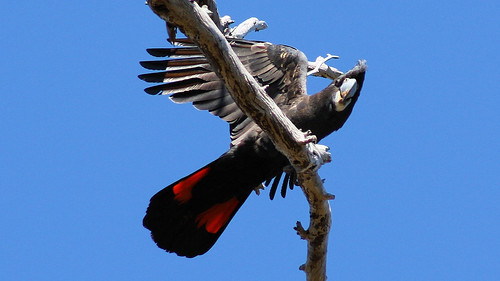 Forest Red-tailed Cockatoo - Male. Image by Sandra WallaceFOREST Industries Federation WA (FIFWA) executive director Bob Pearce has hit out over claims of diminishing food sources in Warrup and Helms by the WA Forest Alliance (WAFA).
Forest Red-tailed Cockatoo - Male. Image by Sandra WallaceFOREST Industries Federation WA (FIFWA) executive director Bob Pearce has hit out over claims of diminishing food sources in Warrup and Helms by the WA Forest Alliance (WAFA).
"(Recently) the same group was claiming Helms block near Nannup is the last refuge for these birds.
“That was when they thought that harvesting was about to begin in Helms.
“Now that harvesting has begun in Warrup Block instead, they have had to change their story.”
Mr Pearce said there were 1.2 million hectares of forest in national parks and natural reserves available for cockatoo habitats and feeding, and tens of thousands of hectares of natural parks in the area around Warrup.
"There are a further 1.1 million hectares of trees in state forest available for the cockatoos,” he said.
“Harvesting operations in Warrup will cover at most 1000 hectares, leaving behind many trees, including mature habitat trees and most marri trees, the main food source for cockatoos.
"From these figures it is clear any impact of forestry operations on cockatoos feeding grounds or habitat is negligible.
“WAFA relies on public ignorance of these figures in spinning their tales.
"To paraphrase Samuel Johnson, this kind of falsehood is the last refuge of scoundrels.”
WAFA convenor Jess Beckerling said South West forests and wildlife were under enormous strain from the combined impacts of drought, dieback, marri canker, prescribed burns and habitat loss and fragmentation from ongoing logging and clearing.
Ms Beckerling said WA's black cockatoos were endangered and threatened with extinction because they did not have sufficient habitat.
"FIFWA has a strong vested interest in continued logging of native forests and is attempting to undermine those in the community who are passionately trying to protect the remaining habitat for these wonderful birds but the truth remains that logging causes habitat loss and habitat loss is pushing the black cockatoos to likely extinctions," Ms Beckerling said.
"The few remaining areas of good quality habitat that haven't been intensively logged or burnt are critical to the survival of the cockatoos and other wildlife.
“Logging and clearing have removed or disturbed the vast majority of the South West forests with serious consequences to our wildlife and forest health.
"Warrup, Helms and Arcadia are the areas under the most imminent threat and they, like other areas, are all critical refuges for cockatoos that require urgent protection.
“It is self evident that the cockatoos are suffering from a lack of habitat; they wouldn't be endangered otherwise.”
Scientist and academic, Dr Beth Schulz condemned Mr Pearce's comments as 'spin'.
"His comments are misleading,” Dr Schulz said.
“If only it were true when he says 1.2 million hectares of forest in national parks and natural reserves were available as cockatoo habitat.
"Mr Pearce fails to mention it is only 27 per cent of national parks and natural reserves that is old growth and has not been logged that would have the full complement of big old trees with hollows that cockatoos must have for nesting and breeding.
"In state forest, it's forest selectively logged before the mid 1980s that still has lots of big old trees and this forest is disappearing fast because it's only the big old trees that the sawmills want.
“They are not interested in regrowth.
"Regenerating forest, whether in national parks or state forest, won't develop hollows big enough for cockatoos for hundreds of years.
"As for forest providing food for cockatoos, it should but much of it doesn't because it gets burnt.
“The Department of Environmental Conservation (DEC) aims to burn 200,000 hectares in the South West every year.
“When the crowns of the marri trees get burnt, as often happens, the trees won't produce nuts, a principal food source for cockatoos, for five or six years."